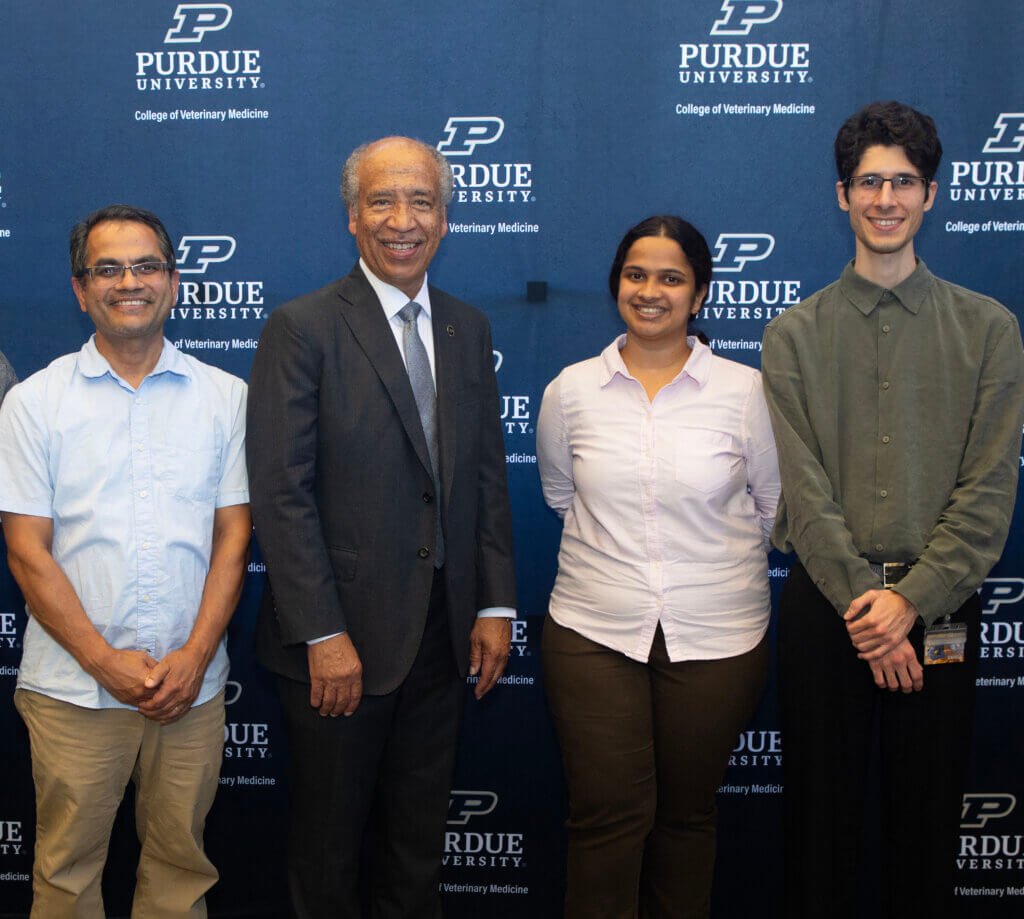Identification of nuclear protein’s critical role in cell degradation could lead to prevention or even reversal of age-related diseases

Tantalizing legends of a fountain of youth spurred explorers to navigate the globe for millennia in search of the restorative waters that promised to wind back the hands of time and halt the process of aging. Recent research conducted in the Purdue University College of Veterinary Medicine and the Bindley Bioscience Center reveals the real secret lies not in myth, but in science.
As we age, our cells undergo senescence, a process where they cease dividing and enter a state of permanent growth arrest without dying off. Senescence is actually a good thing, because if cells continue to divide uncontrollably, they become tumorigenic or cancer-initiating cells. It’s when too many senescent cells build up that they cause problems.
Our immune system can eliminate damaged cells through apoptosis, but that process becomes less effective as we age. So instead of being naturally discarded, these damaged senescent cells hang around and release chemicals that can trigger inflammation. The older we get, the more our senescent cells accumulate and compromise healthy cells.
“It’s like a basket of fresh apples that becomes tarnished by one bad apple,” says Uma K. Aryal, PhD, research associate professor in the Department of Comparative Pathobiology and director of the Purdue Proteomics Facility in the Bindley Bioscience Center. “Once the bad apple starts rotting, it affects all the neighboring good apples.”
Cellular senescence has been linked to age-related diseases including cancer and neurological diseases such as Alzheimer’s and Parkinson’s. Unmasking the mechanism that underpins cellular senescence could lead to earlier detection of such diseases or perhaps, one day, prevention.

In a study published in the February 2024 journal Molecular & Cellular Proteomics, Aryal and his research team identified a specific protein, known as Pin1 — a peptidyl-prolyl cis/trans isomerase — that appears to play a key role in regulating the senescence process. Aryal served as principal investigator for the study. Rodrigo Mohallem, a graduate research assistant and PhD candidate in Aryal’s lab, conducted the experiments. Funding for the project was provided partially by the Indiana Clinical and Translational Science Institute, the Showalter Trust Fund and the Purdue University COVID Disruption Fund. Funding for open access publication of this research was provided by the Purdue University Libraries.
There are many triggers for oncogene-induced senescence. An oncogene is a mutated gene that has the potential to transform into a tumor cell under certain circumstances. In this study, Aryal and Mohallem used a model that activated RAS proteins to induce senescence in human fibroblast cells. By controlling when senescence was triggered to the cell, they could collect comparative data through longitudinal studies throughout the senescence process.
Using the proteomic and phosphoproteomic technologies available in the Bindley Bioscience Center, they identified the proteins and phosphoproteins that change as cells undergo senescence. These proteins are like molecular fingerprints for different physiological stressors, including disease. The mass spectrometers housed in the Purdue Proteomics Facility can monitor thousands of proteins and hundreds of thousands of peptides in a single experiment. This enabled the research team to zero in on Pin1.
“Identifying Pin1’s role in oncogene-induced senescence is critical to understanding the mechanisms that drive cells into senescence,” says Mohallem. “Understanding senescence helps us to understand the aging process and why our bodies become more fragile as we become older. This can lead to more advanced therapeutic strategies to help older people live healthier, more active lives.”
By analyzing the relationship between Pin1 and promyelocytic leukemia, or PML protein, the researchers gained valuable insight into the senescence process. PML proteins act as tumor suppressors, preventing cells from growing and dividing too rapidly or in an uncontrolled manner. The PML protein is the main component of PML nuclear bodies (PML-NBs) and serves as a molecular glue to build up these nuclear bodies.
“Dr. Aryal’s study shows that the protein Pin1 helps form and maintain PML nuclear bodies, which are structures in the cell nucleus involved in processes that can malfunction in aging and cancer,” says Thomas Sors, PhD, director of scientific strategy and relations for the Purdue Institute of Inflammation, Immunology and Infectious Disease. “His work is significant because it can potentially lead to new treatments for cancer and neurodegenerative diseases such as Alzheimer’s.”
These PML-NBs are formed by a process called liquid-liquid phase separation (LLPS) and are used as sites for sequestration, inactivation and degradation of certain proteins involved in cell proliferation and tumorigenesis. However, as cells age, their ability to accumulate such proteins into PML-NBs and degrade them lessens. When proteins within PML-NBs cannot be recycled or degraded, they begin to aggregate and become misfolded. Proteins must be correctly folded into specific, 3D shapes to function correctly.
Pin1 binds to PML proteins, changing the PML protein structure and triggering its activation. When the process was disrupted, the cells became tumorigenic. Understanding how PML-NBs are formed and how proteins are recruited into PML-NBs will build greater understanding of how to create more efficient cells that recycle those proteins over and over, rather than allowing them to aggregate. That means better treatment for patients with diseases such as Alzheimer’s.
“Aging is directly linked to neurological disorders,” Aryal says. “If we can identify molecular signatures of the aging process, we may be able to figure out biological markers that indicate whether a person is more susceptible to developing Alzheimer’s disease, and we can develop medications and therapies to slow the progression. Knowledge of the connection between Pin1 and PML nuclear bodies can be used to advance the identification of those markers.”
The breakthrough was facilitated by a $3.5 million investment in proteomics equipment by the Office of Research to furnish the Purdue Proteomics Facility. The mass spectrometry instruments are available to researchers across campus.
“Proteomics is a very powerful science,” Aryal says. “In this study, we were specifically interested in two proteins, Pin1 and PML, but during our experiments, interactions with hundreds of other proteins also were impacted. The proteomics technology allows us to monitor everything occurring within the cell simultaneously.”
With the number of Americans aged 65 and older projected to increase from 58 million to 82 million by 2050, uncovering the secrets of aging and reversing the process of age-related diseases is more pertinent than ever. Scientific discovery has the potential to aid a natural biologic process and help cells function more effectively and efficiently as we age. It’s not exactly a fountain of youth, but it is a promising step toward increasing the years of independent, healthy living for older generations.
“Senescence is an evolutionary process that developed to prevent cells from becoming tumorigenic, but our bodies have not evolved to protect us naturally from disease,” Aryal says. “Cancer can still arise when cells evade senescence or when other factors, such as mutations or environmental or chemical exposure, disrupt normal cellular process. We can treat cancer and we can cure cancer, but we cannot reverse cancer — with greater understanding of senescence, perhaps in the future, we will.”

